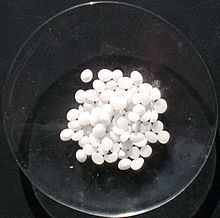
Back محلول قلوي Arabic Луг (рашчына) BE-X-OLD Луга Bulgarian Сĕлтĕк CV Lleisw Welsh Alkalische Lösung German Αλισίβα Greek Alsìa EML Lesivo Esperanto قلیاب Persian


A lye refers to sodium hydroxide and potassium hydroxide. The word lye most accurately refers to sodium hydroxide (NaOH),[citation needed] but historically has been conflated to include other alkali materials, most notably potassium hydroxide (KOH). In order to distinguish between the two, sodium hydroxide may be referred to as soda lye while potassium hydroxide may be referred to as potash lye.
Traditionally, it was obtained by using rainwater to leach wood ashes (which are highly soluble in water and strongly alkaline) of their potassium hydroxide (KOH). A caustic basic solution is produced, called lye water. Then, the lye water would either be used as such, as for curing olives before brining them, or be evaporated of water to produce crystalline lye.[1][2]
Today, lye is commercially manufactured using a membrane cell chloralkali process. It is supplied in various forms such as flakes, pellets, microbeads, coarse powder or a solution. Lye has traditionally been used as a major ingredient in soapmaking.
- ^ "How to make lye". wikiHow. 15 January 2024. Retrieved 24 January 2024.
- ^ Garms, Gabe (9 December 2015). "Turning your wood ash into lye for soap making". Raven’s Roots Naturalist School. Retrieved 24 January 2024.